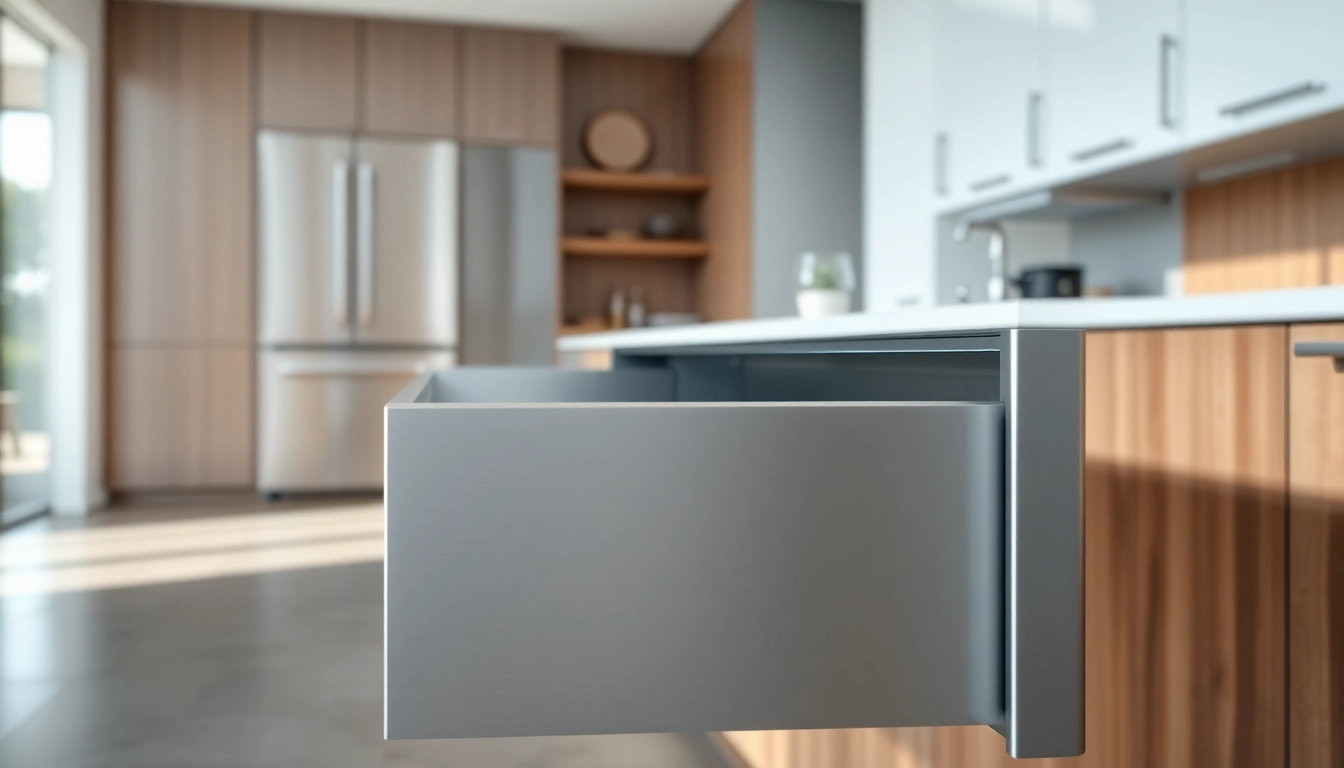Understanding the Metal Drawer System
In both residential and commercial furniture design, functionality and durability are key factors that dictate the performance of drawers. A Metal Drawer System stands out as a versatile solution in cabinetry, providing sturdiness alongside precision engineering. This article delves deep into the heart of metal drawer systems, dissecting their components, benefits, applications, types, installation, maintenance, and best practices to ensure a long-lasting investment.
What is a Metal Drawer System?
A metal drawer system is a high-performance assembly primarily made from metal—typically steel or aluminum—designed to support various drawer functions within a cabinet or a piece of furniture. This system includes drawer slides that assist with smooth opening and closing operations, alongside boxes that house the items stored within. The materials used in metal drawer systems provide them with strength and resilience, making them an ideal choice for both heavy-use settings such as workshops and lighter applications in homes.
Benefits of Using Metal Drawer Systems
Metal drawer systems offer several distinct advantages over traditional wooden drawer mechanisms. Here are some prominent benefits:
- Durability: Metal, particularly steel, resists warping, cracking, and pest infestations, ensuring a longer lifespan for the drawer system.
- Load-bearing Capacity: Metal systems often feature robust structures that can handle significant weight, making them suitable for heavy tools and kitchen appliances.
- Smooth Operation: The engineering behind metal drawer slides allows for smoother and quieter operation, reducing the noise typically associated with standard wood drawer slides.
- Design Versatility: Metal drawer systems can feature various finishes and designs, allowing them to seamlessly integrate into modern or traditional styles.
- Environmental Resistance: Many metal drawer systems are treated to resist moisture, rust, and temperature fluctuations, making them suitable for diverse environments.
Common Applications and Installations
Metal drawer systems find their place in a wide range of applications, namely:
- Offices: Utilized in desks and filing cabinets for organization and ease of access.
- Kitchen: Ideal for cooking tools, dinnerware, and spices, ensuring efficient kitchen workflows.
- Workshop: Perfect for storing tools and heavy equipment, offering a durable solution for trade professionals.
- Retail Displays: Used in displays that require both aesthetics and functionality, enhancing the shopping experience.
Types of Metal Drawer Systems
Metal drawer systems can be categorized into several types, each with features tailored to specific usages:
Ball Bearing Drawer Slides
Ball bearing slides are one of the most commonly used types of metal drawer slides. These slides utilize small metal balls housed within the slide’s rails to facilitate smooth, low-friction movement. The advantages include:
- Exceptional Load Capacity: They can support heavier drawers without sagging.
- Ease of Installation: Ball bearing slides typically come with straightforward installation instructions, making them accessible even for DIY projects.
- Noise Reduction: The ball bearing mechanism significantly reduces noise during operation.
Soft Close Mechanisms
Soft close drawer systems are designed to prevent slamming and enhance the user experience. These systems utilize hydraulic or pneumatic mechanisms to slow the drawer’s closing action, providing a gentle and quiet closure. Benefits include:
- Safety: Reduces the risk of pinched fingers, particularly beneficial in homes with children.
- Convenience: No need for users to fully close the drawer; it automatically seats itself securely.
Heavy-Duty Models
Heavy-duty metal drawer systems are engineered for maximum strength, often including reinforced sides and specialized supports to handle extreme loads. Ideal for:
- Industrial Applications: Providing storage for heavy equipment and tools.
- Commercial Use: Ensuring that drawers in retail or storage settings can support weighty inventory without deforming.
Choosing the Right Metal Drawer System
The selection process for a metal drawer system requires careful consideration of several factors to ensure optimal functionality. Here are important factors to evaluate:
Factors to Consider Before Purchase
Before purchasing a metal drawer system, consider:
- Application: Identify the environment and intended use. Residential, industrial, and commercial settings have different requirements.
- Handling Capacity: Assess the weight that the drawers need to support, as this will affect your choice between standard and heavy-duty systems.
- Drawer Dimensions: Ensure the drawer system fits within the designated cabinetry or furniture piece.
- Style: Match the design aesthetics of the drawer system with your other furniture pieces for a cohesive look.
Material Quality and Durability
The material used in the construction of the metal drawer system significantly impacts its durability and longevity. Check for:
- Gauge Thickness: Thicker gauge metals offer improved durability.
- Finish Coating: A corrosion-resistant finish increases resilience to moisture and scratches.
Size and Space Requirements
Every space has different dimensional restrictions, making it crucial to measure the area where the metal drawer system will be installed. Consider both the depth and size of the drawers to maximize usability while retaining accessibility.
Installation Guide for Metal Drawer Systems
Installing a metal drawer system can be straightforward, especially with the proper tools and instructions. Below is a comprehensive guide:
Tools and Materials Needed
To successfully install a metal drawer system, gather the following:
- Drill and drill bits
- Screws, brackets, and hardware components
- Level
- Measuring tape
- Wood glue (if applicable)
- Safety goggles and gloves
- Installation manual
Step-by-Step Installation Process
Here’s a step-by-step process for installing a metal drawer system:
- Measure and Mark: Use measuring tape to mark where the drawer slides will go on the side of the cabinet or enclosure.
- Attach Drawer Slides: Secure the slides to the marked areas using your drill and screws.
- Install Drawer Box: Carefully align the drawer with the installed slides and push it into place.
- Test Functionality: Open and close the drawer to ensure smooth operation and make necessary adjustments.
Common Mistakes to Avoid
Be aware of these common pitfalls during installation to ensure optimal function:
- Not ensuring level alignment, which can result in improper operation.
- Over-tightening screws, which can lead to distortions in the system.
- Leaving insufficient space for the drawer to fully extend and close.
Maintenance and Care for Metal Drawer Systems
Regular maintenance is vital for the longevity of your metal drawer system. Implementing a care routine can help mitigate issues and maintain optimal performance.
Regular Cleaning and Upkeep
To maintain metal drawer systems:
- Dust regularly to prevent buildup and potential wear on the slides and interiors.
- Wipe down surfaces with a damp cloth and mild detergent; avoid abrasive materials that might scratch the surface.
- Lubricate slides periodically using appropriate lubricants, ensuring smooth operation.
Signs of Wear and When to Replace
Several indicators may signal that it’s time to replace your metal drawer system:
- Frequent Sticking: Difficulty opening or closing the drawer may indicate a need for lubrication or a complete replacement.
- Visible Damage: Bends or rust on the slides suggest it’s time for a swap out.
- Excessive Noise: If you notice increased squeaking or grinding, investigate for possible misalignments or defects.
Enhancing Longevity Through Care
Adding protective measures can prolong the life of your metal drawer systems:
- Utilize drawer liners to protect interiors from scratches and condensation.
- Ensure the weight capacity is adhered to, preventing undue stress and damage.
- Follow manufacturer guidelines for maintenance to keep warranties valid.



